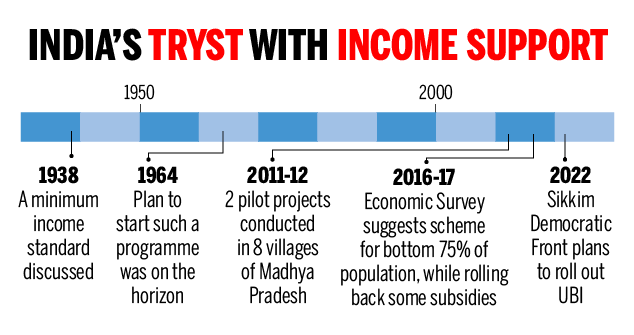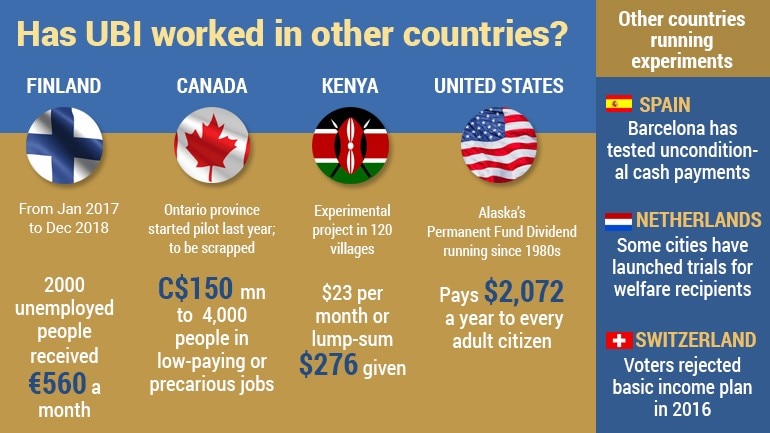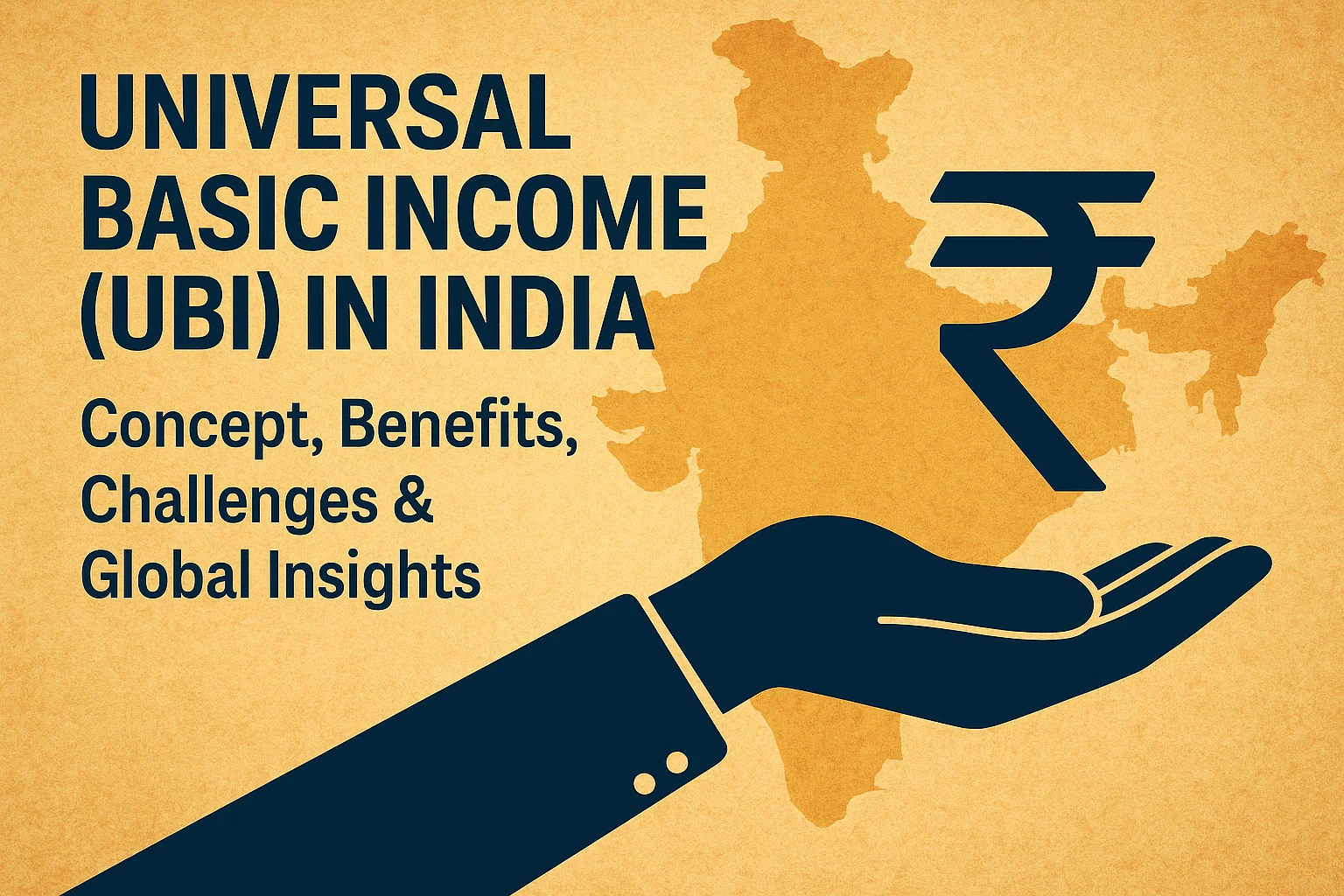Universal Basic Income (UBI) in India : Concept, Benefits, Challenges & Global Insights
Explore the concept of Universal Basic Income (UBI) — its meaning, benefits, challenges, and global experiments. Learn how UBI can address poverty, inequality, and job insecurity, along with India’s policy perspective from the Economic Survey 2016–17. A must-read for UPSC aspirants and public policy enthusiasts.
Universal Basic Income (UBI): Concept, Challenges, and Implementation in India
The Universal Basic Income (UBI)—a periodic, unconditional cash payment to all citizens—has transitioned from a theoretical idea to a serious policy contender.
What is Universal Basic Income?
- Universal Basic Income (UBI) is a social welfare proposal where all citizens, or residents, of a country receive a regular, unconditional sum of money from the government.
- The Economic Survey 2016-17, which dedicated an entire chapter to UBI, described it as a “powerful idea” whose time had come for serious deliberation. It conceptualised UBI as an efficient substitute for a plethora of existing social welfare schemes, aiming to reduce administrative complexity and ensure a minimum level of economic security for every citizen.
What are the major benefits associated with it?
The potential benefits of UBI, as highlighted in policy discussions including the Economic Survey, are multi-faceted:
- Poverty Reduction and Inequality Mitigation: A UBI provides a direct and predictable income floor, effectively lifting all citizens above a minimum standard of living.
- Administrative Efficiency: By replacing or consolidating a complex web of targeted schemes, it would reduce the administrative costs and resources spent on identifying beneficiaries, thereby minimising “leakage” and corruption.
- Agency and Freedom: Unlike in-kind transfers or conditional subsidies, cash gives recipients the freedom to prioritise their needs—be it nutrition, education, healthcare, or starting a small business.
- Coping with Precarity: In an era of gig work and job-shedding automation, UBI acts as a cushion. It provides security for workers between jobs, supports unpaid care work (predominantly done by women), and offers a safety net during economic transitions or climate-induced disruptions read the full material here.
What are its challenges?
- Fiscal Cost: The Economic Survey 2016-17 calculated that a UBI of just ₹7,620 per year (equivalent to the poverty line then) would cost about 4.9% of GDP.
- “Universality vs. Targeting” Debate: A key concern is that giving money to the rich is fiscally wasteful and dilutes the redistributive intent. Critics argue that in a resource-constrained country like India, welfare should be sharply targeted at the poorest.
- Potential for Moral Hazard: A common worry is that UBI might reduce the incentive to work. However, pilot studies in India and elsewhere have largely debunked this, showing minimal impact on workforce participation.
- Implementation and Exclusion Errors: The very infrastructure meant for inclusion (Aadhaar, bank accounts) could inadvertently exclude some.

Has it been successful in other countries?
No country has implemented a nationwide, permanent UBI. However, several pilot projects and experiments have yielded valuable insights:
- Finland (2017-2018): A two-year experiment with 2,000 unemployed individuals found that while it did not significantly increase employment, it markedly improved the recipients’ well-being, mental health, and confidence.
- Kenya (GiveDirectly program): Long-term studies of unconditional cash transfers in rural Kenya found sustained benefits, including increased assets, livestock, and consumption, with no evidence of increased spending on alcohol or tobacco.
- Iran: Iran implemented a nationwide cash transfer scheme to compensate for the phasing out of food subsidies. Studies showed it reduced poverty and inequality, though it did lead to some inflationary pressures.
- India (Madhya Pradesh Pilot): A pilot study funded by UNICEF and conducted by SEWA in Madhya Pradesh found that UBI villages showed significant improvements in nutrition, school enrollment, and sanitation compared to control villages, and there was no decrease in work effort.

What measures can be taken to ensure Universal Basic Income?
- Phased Implementation: Instead of a nationwide rollout, UBI could be introduced for specific vulnerable groups first, such as women, the elderly, or residents of particularly impoverished districts. This “UBI-for-the-poor” approach was suggested as a starting point in policy discussions.
- Rationalisation of Subsidies: A careful cost-benefit analysis of major central sector and centrally sponsored schemes could identify areas for rationalisation.
- Strengthening the JAM Trinity: The success of UBI hinges on the robustness of the Jan Dhan-Aadhaar-Mobile (JAM) infrastructure. Efforts must be intensified to achieve universal financial inclusion, improve digital literacy, and ensure last-mile connectivity.
- UBI as a Complement, Not a Substitute: Initially, UBI could run parallel to essential in-kind schemes like the Public Distribution System (PDS) and the Mahatma Gandhi National Rural Employment Guarantee Act (MGNREGA), allowing for a gradual transition and evaluation of outcomes.
Subscribe to our Youtube Channel for more Valuable Content – TheStudyias
Download the App to Subscribe to our Courses – Thestudyias
The Source’s Authority and Ownership of the Article is Claimed By THE STUDY IAS BY MANIKANT SINGH



